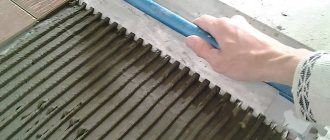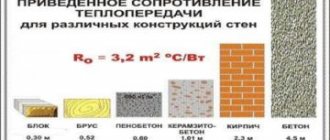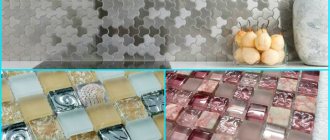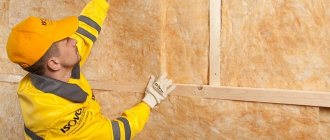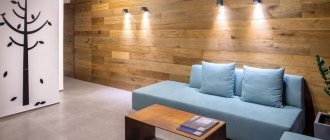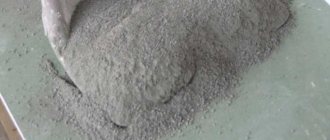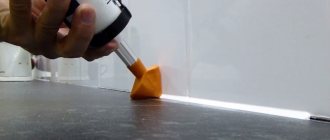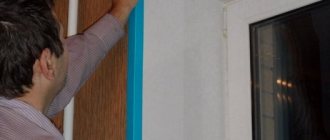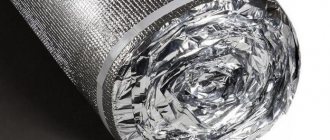The strength of the structure as a whole depends on the quality of the glue used for laying expanded clay concrete blocks.
After all, it is this binding composition that is responsible for the adhesion of building elements to each other.
Therefore, it is so important to know what glue is used for laying expanded clay concrete blocks, what is included in its composition, what its pros and cons are, and how to use it correctly. Read about this and more in the article.
What adhesive composition are used to lay expanded clay stones?
For laying expanded clay concrete blocks, three types of compositions are used :
- universal;
- heat-saving;
- winter.
Each of these compositions has its own characteristics that need to be taken into account before making a choice.
Classical
Classic glue is used for laying expanded clay concrete and other porous blocks. It contains no components that would give it special properties.
This glue can be used during construction in the warm season. It fills defects, chips and unevenness well, is economically consumed and inexpensive.
Manufacturers:
- Founded by Seloform.
- Hedgehog.
- Masterblock De Luxe.
- Ytong for thin joint masonry.
The main disadvantage of classic glue is that it does not contain additives that allow it to work at sub-zero temperatures.
Winter
The main feature of winter glue is the ability to use it in the cold season . It contains components that prevent the composition from freezing at sub-zero temperatures. In the cold it does not deform and does not lose elasticity.
Use at temperatures down to -10 degrees.
Winter composition brands:
- Dauer Block. Contains antifreeze additive down to -10 degrees.
- AeroStone. Winter adhesive for thin-seam masonry walls up to -10 degrees.
- Ytong winter.
The use of winter adhesives allows you to avoid the formation of cold bridges and lay out the blocks evenly and cleanly. Most of these compositions are marked not only “frost-resistant”, but also “moisture-resistant”.
The disadvantages of winter composition include higher cost , so if work is carried out in the warm season, it makes no sense to buy it.
Heat saving
Heat-saving adhesive avoids the formation of “cold bridges”. As a result, the room is always maintained at a comfortable temperature. Heated air does not leak through the cracks that can form when laying blocks with conventional mortars.
Manufacturers:
- Thermal insulating masonry mixture Promix with a reduced thermal conductivity coefficient.
- Masonry thermal insulation adhesive Perfekta Linker Thermo Profit.
- Adhesive for cellular concrete Stone Flower Magma.
Heat-saving glue has no disadvantages. The only drawback can be considered the higher cost compared to the classic composition.
The best brands
The construction market offers products from many domestic and foreign manufacturers. According to reviews, concrete adhesive, which is considered one of the best, is produced by Ceresit.
Domestic brands are no less popular:
- "Leader";
- "Polymen";
- "Polyrem."
Demanded products from foreign manufacturers:
- Bostik;
- Findley;
- seder;
- Emfi;
- Knauf;
- Jovi.
Advice! The leading position as a mixture used for cellular concrete is occupied by the Monolith brand.
What does the material contain?
The composition of the adhesive for expanded clay concrete blocks includes the following components :
- Portland cement. It acts as the main binding agent.
- Sand. To produce high-quality glue, fractionated sand that has undergone purification is used. It is necessary to give the mass plasticity. When there is a temperature difference, it is the sand that prevents the wall from cracking.
- Polymers . They are needed to fill chips and unevenness on the blocks. Thanks to polymers, the adhesion of the adhesive to the surface increases.
- Modifiers . They prevent the formation of cracks in the adhesive base and prevent heat from leaving the room.
All components included in the adhesive must be indicated on the packaging. If this information is missing, you should not purchase such a product.
How to cook it correctly?
In order for the glue to fully exhibit its adhesive properties, it must be properly prepared. Depending on the manufacturer, the instructions may differ, but significant deviations from the universal algorithm are rare.
The procedure is as follows:
- Water is poured into a suitable container in the amount needed to prepare the adhesive mixture. The exact proportions are indicated on the packaging. The water must have the optimal temperature, which is indicated in the instructions.
- Pour dry glue from the pack into the water.
- Mix the mixture until a uniform base is obtained. To ensure that there are no lumps left in the glue, it is recommended to use a construction mixer. As a result, the sticky mass should resemble sour cream. When applied to blocks, it should not flow or spread.
- Let the mixture brew. This will take about 10 minutes.
If it was not possible to use the entire composition, you should not leave it for storage. After hardening in the container, the glue loses its properties, which do not return when re-moistened.
Types of blocks used
The choice of cellular concrete as the main building material is due to a reduction in the labor intensity of installation work and a significant reduction in construction costs. The consumption of assembly adhesive for blocks is several times less than the cost of cement-sand mortar for bricklaying. Manufacturers produce several types of building blocks made of cellular concrete that can be installed with glue:
- Expanded clay concrete. A characteristic feature is a combination of high strength and low specific gravity. The composition of the building material includes small expanded clay granules (fraction 5-10 mm). The operational service life of the products is 75 years. Area of use: construction of houses, cottages, outbuildings. There are solid, hollow, structural and thermal insulating blocks made of expanded clay concrete.
- Cement-sand (concrete). They are used in low-rise construction much less frequently, since concrete products without fillers have poor thermal insulation characteristics. The blocks do not contain cells or pores, so the material is heavier and places significant loads on the foundation. Outbuildings are built from concrete blocks, since the material has good strength and frost resistance.
- Gas silicate. The walls of houses made of gas silicate blocks retain heat well and provide an optimal indoor microclimate. A prerequisite for construction is the use of high-quality glue during installation and the installation of external cladding, which protects the structure from atmospheric moisture and has vapor-tight properties. Porous blocks are characterized by low thermal conductivity, optimal dimensions and low weight.
- Polystyrene concrete. Blocks containing polystyrene are characterized by high frost resistance and sound insulation properties. The use of adhesive for polystyrene concrete blocks allows the construction of durable monolithic structures in private and industrial construction. The material contains polystyrene granules with a fraction of up to 20 mm and white quartz sand, which give the products frost resistance.
- Foam blocks. Cellular concrete with finely dispersed aggregate is inferior in strength to aerated concrete, the production technology of which is significantly different. Foam blocks have a low cost, their strength is sufficient for the construction of 2-3-story buildings. It is difficult to work with foam blocks due to the violation of the geometry of the material. To obtain more durable structures, it is better to use tongue-and-groove blocks.
Block-type building materials also include other products. Concrete with wood filler (arbolite) has the best vapor permeability and high seismic resistance. Wood concrete is a non-flammable, soundproof and environmentally friendly material. Similar characteristics are characteristic of sawdust concrete, in which sawdust rather than wood chips act as a filler.
Interesting! To build houses with beautiful facades, you can use ceramic hollow blocks of attractive shapes. Combined type blocks with heat-insulating layers and a textured layer (multi-layer “pie” with insulation) are gradually gaining popularity - heat block, heat wall, porotherm, polyblock.
Flow calculation
To correctly calculate the glue consumption, you need to take into account the characteristics of the coating on which it will be applied, as well as the experience of the worker doing the laying.
The average consumption for calculating the mixture is as follows:
- For 1 m2 of blocks with a layer thickness of 1 mm, it takes from 1.3 to 1.7 kg of dry glue.
- A standard bag of glue weighs 25 kg. This volume should be enough for blocks with an area of 1 m3.
- To prevent the glue from running out at the most inopportune moment, you need to add another 10-15% of dry matter to the calculations obtained, since more glue will be consumed during the work. In some areas, cracks and chips will have to be repaired; in some areas, the technician may accidentally drop some of the adhesive, etc.
You should not try to reduce glue consumption by reducing the thickness of the masonry. This will affect the quality of construction. In order not to waste excess dry matter, you need to dilute it in a small amount: enough to last for an hour of work.
Criterias of choice
The selection and purchase of the optimal adhesive composition must be accompanied by compliance with certain criteria. A specialist consultant in a hardware store must take into account the following factors in order to determine which adhesive for laying gas silicate blocks is better:
- Manufacturer and brand. Popular manufacturers of building materials take care of their reputation and carefully monitor the quality of their products. Products from such a manufacturer are more expensive, sometimes several times more. However, if impeccable quality is required, the choice should be made in favor of such brands. By the way, very often in construction stores and showrooms there are promotional offers on products from well-known brands.
- Conditions under which the substance is stored. All dry concentrate must be located in a ventilated area. If the product is located on shelves where there is high humidity, or the packaging is damaged, it is considered unsuitable, since it can reduce the quality of the masonry.
- If possible, the choice should always be made in favor of a manufacturer that supplies not only glue, but also gas silicate blocks.
- The main factor: before purchasing, you should always calculate the material (amount of glue) required for construction.
You need to be guided by the following formula: if the layer thickness is no more than 3 mm, then 8-9 kg of composition will be required per 1 m3 of surface.
Features of work
When using glue for laying expanded clay concrete blocks, you need to take into account the following features of its use:
The building material must be clean. It is unacceptable for snow, dirt, sand, oils or other deposits to stick to it.- For gluing, you can use blocks with intact geometry. If they have chips, cracks or unevenness, they refuse to lay such elements, since it will not be possible to achieve a strong adhesion.
- Before using glue, you should carefully read the manufacturer's instructions. The classic composition is diluted at a temperature of +10 degrees (unless otherwise indicated on the package).
- It is not recommended to dilute a large amount of glue in advance. The mixed mass must be used completely.
- To ensure that the glue does not stagnate during work, it must be stirred periodically.
- If the masonry is uneven, there is a shortage or excess of glue in some area, or other adjustments are required, they must be made immediately.
- Until the composition completely sets, the erected structure is covered with a tarpaulin. This rule is relevant when using frost-resistant glue.
- Regardless of the type of composition chosen, masonry should not be carried out in bad weather, during precipitation, with strong gusts of wind, or with sudden changes in temperature.
Consequences of technology violation
Due to broken reinforcement or an incorrect process, the following may occur:
- Cracks in the walls or collapses, which will then require you to spend your own time and incur additional costs for repairs.
- Incorrectly made frame, which can change the correct geometry of the walls.
- Curvature of wall masonry due to uneven distribution of load on the walls.
- The protruding parts of the reinforcement from the wall will protrude from the masonry and will not perform reinforcing functions.
If it is impossible to carry out work with reinforcing devices yourself, it is best to seek help from professionals.
How long does it take to set and gain strength?
A high-quality composition cannot set too quickly . However, in some cases, high speed is a production necessity. Therefore, the minimum time this process can take is 15-20 minutes, and the maximum is 3-4 hours.
If the glue takes longer to set, then it may not be a quality material. With such a mixture, the blocks will move out, which will make masonry impossible.
You also need to distinguish between the setting time of the glue and the time required to gain strength. It can range from 1 to 3 weeks.
Tool for applying glue to aerated concrete
The tools used for laying aerated concrete blocks use quite a few simple devices. The main ones are:
- trowel,
- notched spatula,
- toothed bucket,
- carriage.
It’s worth saying more about the carriage. It belongs to professional tools, and the purchase of this device is justified if there are large and constant volumes of work. The carriage allows you to maintain a constant thickness of the seam and simplifies the application of glue due to a special container.
Pros and cons of this material
Advantages of using glue for building walls made of expanded clay concrete blocks:
No smell.- Fast hardening.
- Economical consumption.
- Easy to use.
- High plasticity.
- Small thickness of seams.
- Possibility of use for external and internal work.
- Resistance to mechanical stress.
- Increased adhesion to the surface.
- Possibility of use in winter (if you purchase a special composition).
- Preservation of heat indoors.
Disadvantages of using adhesive solution:
- The need for strict adherence to safety regulations. The product contains chemical components that, if they come into contact with the eyes or skin, cause severe irritation.
- Higher cost of glue compared to classic cement mortars.
- Lack of reusability.
Ceresit
High efficiency of glue application is achieved by adding a special plasticizer. The products of this brand are characterized by improved adhesive properties, minimal slipping of cladding elements and an affordable price. The glue is based on white cement.
"Ceresit 115" is recommended by the manufacturer for use at the following sites:
- old cladding;
- screeds outside the house with heating;
- outdoor swimming pools;
- roofs;
- floor on the balcony or terrace;
- stairs outside buildings.
What other masonry mixtures can be used?
If the blocks have significant unevenness and damage, then instead of glue you can use cement mortar . It is a cheap alternative to adhesive compositions and is used for fastening low-quality blocks.
If the layer of glue when laying blocks is about 1-2 cm, then cement joints can be 5 cm or more wide. However, walls based on such a solution are reliable and durable. Its main disadvantage is the low heat saving rate, with the formation of cold bridges. Therefore, special attention will have to be paid to finishing.
It may seem that using homemade cement mortars is more profitable from an economic point of view. However, its consumption is significantly higher than that of glue, and more time has to be spent on laying .
